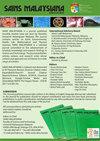Genetic Association Study of Stat4 Polymorphisms and Type 1 Diabetes in Pakistani Children
IF 0.7
4区 综合性期刊
Q3 MULTIDISCIPLINARY SCIENCES
引用次数: 0
Abstract
The present study investigated the relationship of STAT4 single nucleotide polymorphisms (SNPs) rs7574685, rs10181656, and rs3821236 with T1D susceptibility visiting tertiary care hospital in Lahore, Punjab, Pakistan. One hundred and fifty-five T1D patients and one hundred and five healthy individuals were enrolled. An expert endocrinologist collected the clinical data of T1D patients. The genotyping of three potential STAT4 SNPs was performed through Tetra ARMS-PCR assay. The relationship between SNPs and T1D susceptibility under several genetic models, including dominant, recessive, and codominant models, was assessed by regression analysis. All clinical features of T1D demonstrate a significant difference from control groups (P<0.01) except blindness. The characteristic biochemical analysis determined that participants with T1D had significantly higher fasting blood glucose levels and glycated hemoglobin (HbA1c) levels than the control group (P<0.01). Genetic analysis of rs7574685 depicts GT genotype was found to be the risk allele for the development of T1D when compared to the control group. For rs10181656 and rs3821236, the GC genotype and GA genotype were observed to be the risk alleles in the T1D cases as compared to the control group (P=0.04, P<0.01, respectively). Genetic models showed that the STAT4 GG genotype of rs7574685 in the dominant model (OR=1.73, 95% CI=1.05-2.86), GC genotype of rs10181656 in the codominant model (OR=2.079, 95 % CI=1.16-3.71), and AA genotype of rs3821236 showed significant risk association with T1D (OR=3.486, 95% CI=1.72-7.03). It is concluded that the risk of T1D is highly correlated with the STAT4 variants of rs7574685 and rs10181656 among children of the Pakistani population.巴基斯坦儿童Stat4多态性与1型糖尿病的遗传相关性研究
本研究调查了STAT4单核苷酸多态性(SNPs)rs7574685、rs10181656和rs3821236与巴基斯坦旁遮普邦拉合尔市三级护理医院T1D易感性的关系。155名T1D患者和105名健康个体被纳入研究。内分泌专家收集了T1D患者的临床数据。通过Tetra ARMS-PCR分析对三个潜在的STAT4 SNPs进行基因分型。通过回归分析评估了几种遗传模型下SNPs与T1D易感性之间的关系,包括显性、隐性和共显性模型。除失明外,T1D的所有临床特征与对照组相比均有显著性差异(P<0.01)。特征生化分析表明,T1D参与者的空腹血糖水平和糖化血红蛋白(HbA1c)水平显著高于对照组(P<0.01)。rs7574685的遗传分析表明,与对照组相比,GT基因型是T1D发展的风险等位基因。对于rs10181656和rs3821236,与对照组相比,观察到GC基因型和GA基因型是T1D病例的风险等位基因(分别为P=0.04和P<0.01)。遗传模型显示,显性模型中的STAT4-GG基因型rs7574685(OR=1.73,95%CI=1.05-2.86)、共显性模型中GC基因型rs10181656(OR=2.079,95%CI=1.16-3.71),rs3821236的AA基因型与T1D有显著的风险相关性(OR=3.486,95%CI=1.72~7.03)。
本文章由计算机程序翻译,如有差异,请以英文原文为准。
求助全文
约1分钟内获得全文
求助全文
来源期刊

Sains Malaysiana
MULTIDISCIPLINARY SCIENCES-
CiteScore
1.60
自引率
12.50%
发文量
196
审稿时长
3-6 weeks
期刊介绍:
Sains Malaysiana is a refereed journal committed to the advancement of scholarly knowledge and research findings of the several branches of science and technology. It contains articles on Earth Sciences, Health Sciences, Life Sciences, Mathematical Sciences and Physical Sciences. The journal publishes articles, reviews, and research notes whose content and approach are of interest to a wide range of scholars. Sains Malaysiana is published by the UKM Press an its autonomous Editorial Board are drawn from the Faculty of Science and Technology, Universiti Kebangsaan Malaysia. In addition, distinguished scholars from local and foreign universities are appointed to serve as advisory board members and referees.
 求助内容:
求助内容: 应助结果提醒方式:
应助结果提醒方式:


